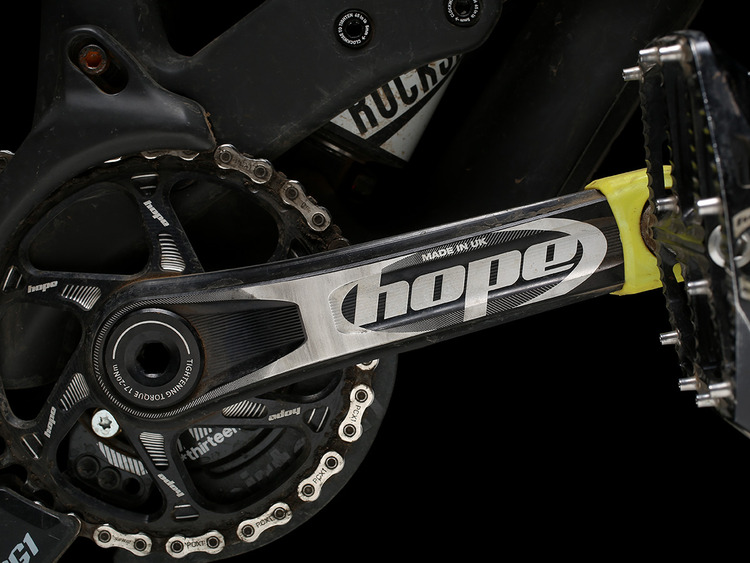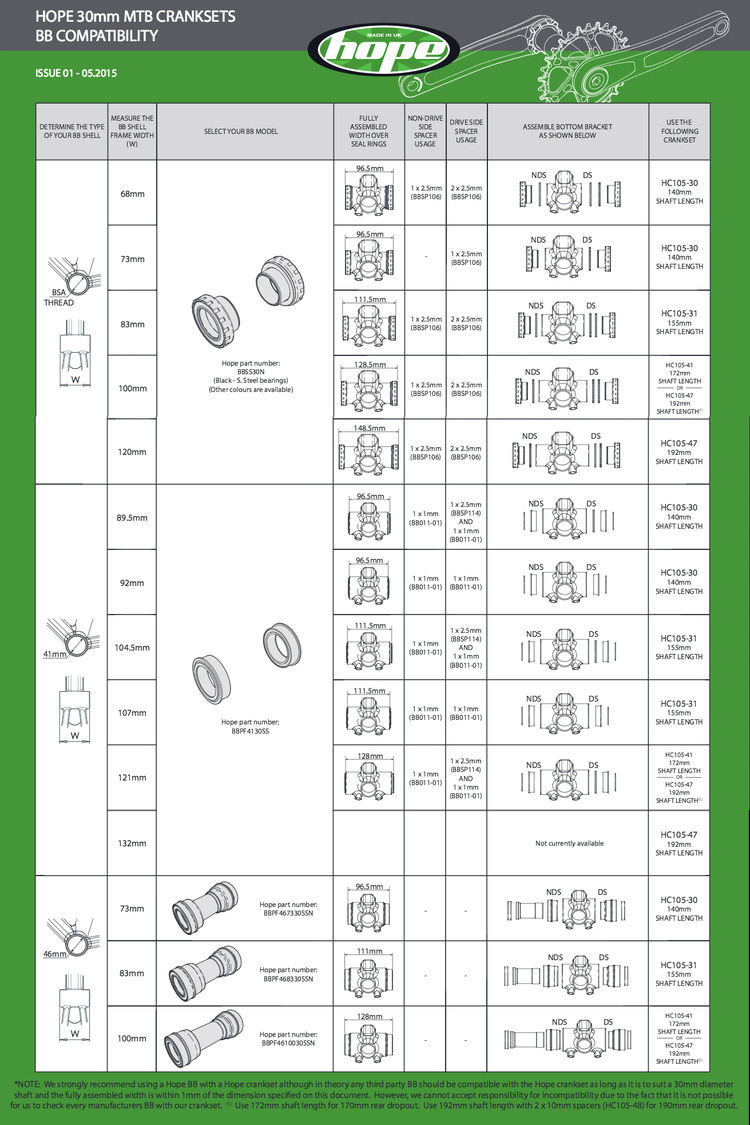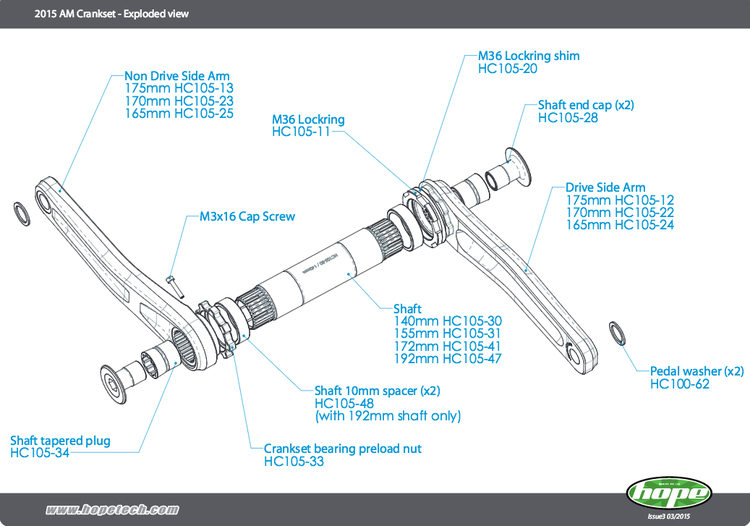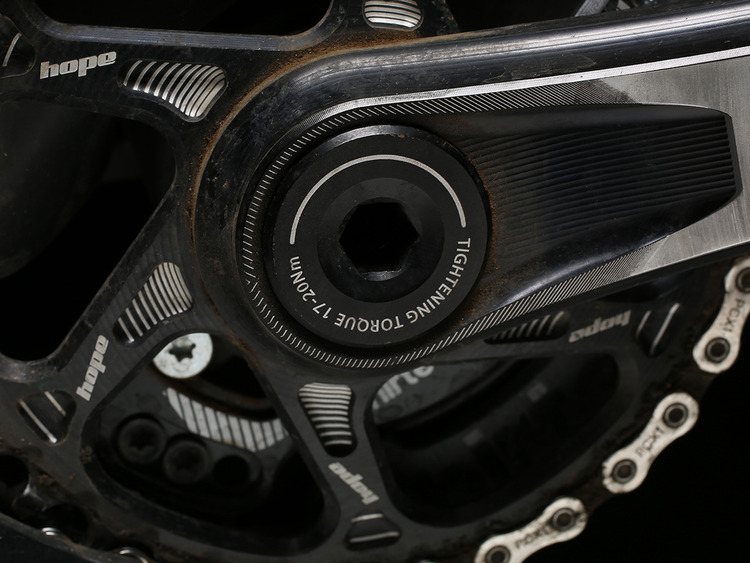Hope Crankset Test
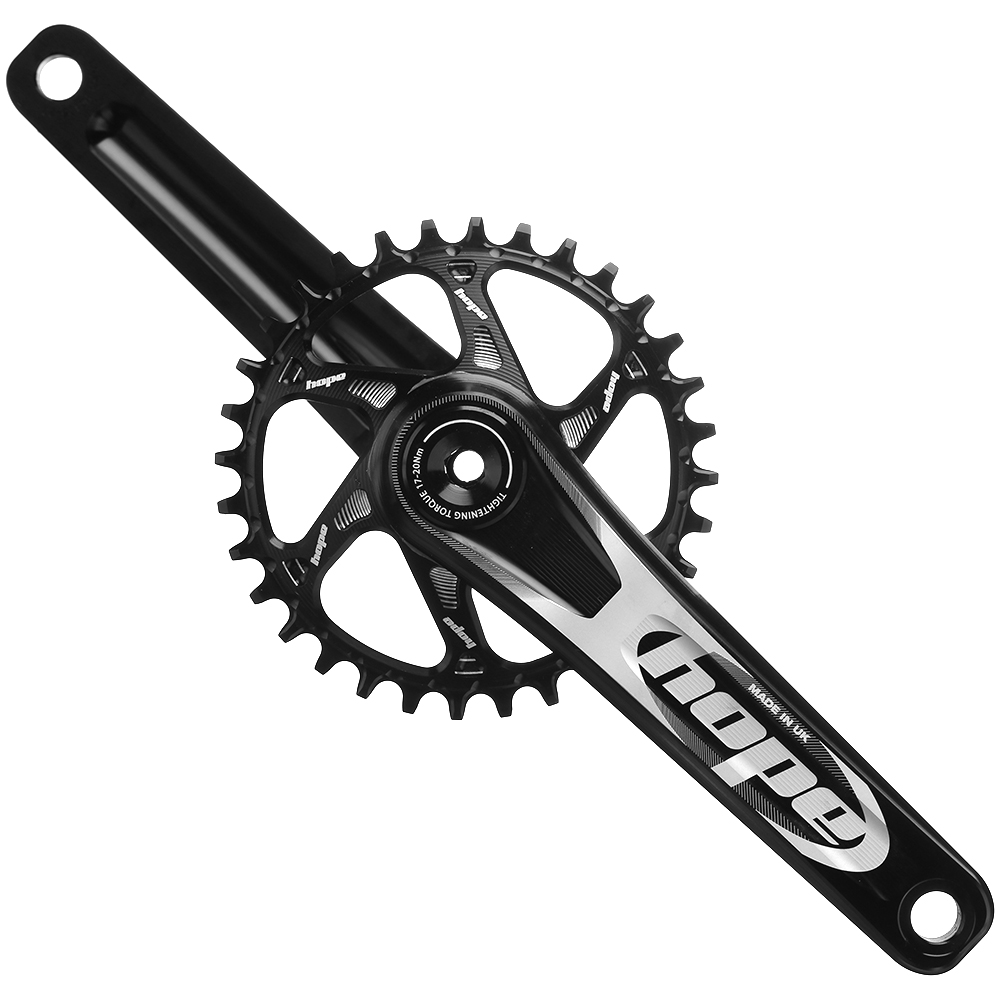
Hope Technology has been around for almost 40 years now. They began making their first disc brakes in the late 1980's. Over the years they have expanded their production to include hubs, stems, pedals, headsets, cranks, BB's, chain rings and a cassette is now in the works. They pride themselves with making all their parts in their home country of England.
Over the years we have owned many Hope products personally. Including Bulb and Big Un hubs, Mono 4, Moto V4 and and the newer Tech V4 brakes. All of their products worked well and their brakes in the past where nothing short of amazing. We decided to get the Hope Cranks to test out on the "enduro" bike and see how these machined works of art performed going "full enduro".
"Hope Technology began life in the late 1980’s as a subcontract machining business making tools and fixtures for the many local aerospace companies. In 1989 they began making disc brakes for the newly developed mountain bikes. Initially for the personal use of the owners Ian Weatherill and Simon Sharp but they quickly realised these brakes could be sold as a product in their own right.
Since disc brakes were such a novel idea on a bicycle they decided to begin manufacturing other more common bicycle products, the first of these being a front hub. These began selling through retailers in the UK and interest was also shown in many countries around the world.
Over the subsequent years many more products were added to the range and in 2000 the decision was made to stop all subcontract work and concentrate purely on bicycle products.
Hope now manufactures almost every part for a bicycle including hubs, brakes, headset, stems, bottom brackets and lights. The only major part left to develop is the actual frame, which may be happening in the not too distant future. All parts are proudly manufactured in Hope’s Barnoldswick factory which is a true state of the art facility. They have almost 100 staff operating the factory 24-7, running the 55 CNC machines, anodising the individual components and hand assembling the finished parts. Manufacturing all products on site gives Hope total control on quality and delivery schedules.
Hope exports around 50% of its production to over 40 countries. They deal directly with retailers in the UK, France, Germany, Austria, Belgium and The Netherlands (employing French and German speaking staff), then have distributors in many other countries. Their components have an excellent international reputation for both quality and reliability. They are generally fitted by enthusiasts looking to upgrade their bikes to the highest levels and are supplied through specialist retailers."
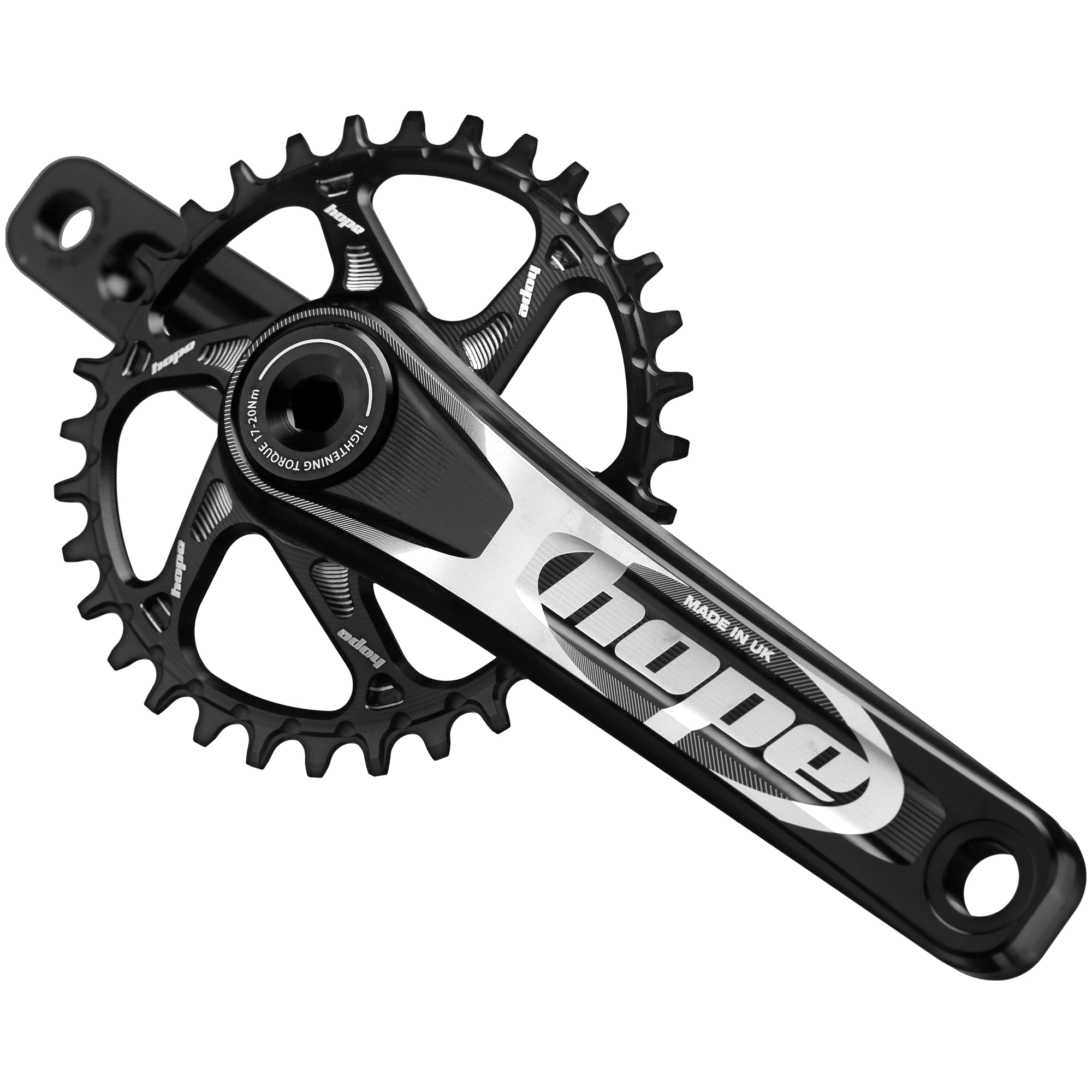
We took our time installing the Hope Cranks into our Evil Insurgent frame. It went in easily and we applied ample grease to the threads in the BB. Once you install the cranks having to take them apart to clean or grease them will take no longer than a traditional crank set would. I am not sure if the expanding spline arm interface is a better way to hold the cranks together or just being done for difference sake. They certainly stayed tight and squeak free for the 5 months we rode them.
Hope Crankset Features
- Forged and CNC machined 7075 series aluminium alloy crank arms
- Unique expanding spline/arm interface (patent pending)
- Versatile Spline mount for chainring/spider
- 165, 170 and 175mm length
- 30mm oversized axle
- Arms available in black, blue, red, silver, purple and orange
- Different axle length options available to accommodate most bikes from XC, DH and FAT bikes
- Weight: 641g (arms, axle and 34 tooth spiderless ring)
Hope Crankset Tech Specs
- Developed over many years the Hope crank has been designed using the latest FEA (Finite Element Analysis) tools and extensive multi discipline field testing.
- The cranks feature a unique expanding spline axle/arm interface (pat pending) and incredibly versatile spline mounted spider/chainring system.
- Our expanded range of bottom brackets ensure compatibility with most bottom bracket systems (See hope cranks compatibility chart)
- Q‐Factor & Chainline- see "crankset fit and chainline" document.
- Several spindle length options available to accommodate most bikes (from XC to DH, including FAT bikes) "see Hope cranks BB compatibility chart".
- Chainring mounting:9, 10 and 11 speed compatible
- Spiderless Retainer chainrings 26T to 36T
- Spider Single 104BCD and Double 64/104BCD (with provisional room for a bashguard on all spiders)
Hope 30mm BB Compatibility
Hope packages the cranks in a clean looking box with foam holding everything secure. Opening the box we found beautiful looking cranks. Hope has been producing high end Mountain Bike components for close to 30 years. Their fit and finish are top notch. Hope includes instructions with the cranks. Make sure you read these as you install the cranks onto the bike. We took our time and everything went together as it should. Their suggested BB spacing was also correct BTW.
Hope Cranks Exploded View
The Hope cranks are a bit heavier than some of their carbon counterparts. The nice thing is that aluminum cranks can take some serious rock strikes without worrying about any possible cracking issues like a carbon crank. If you look at other aluminum cranks they are right there in that 600 gram range. Another thing to think about is labor standards, pollution, and how renewable a material is.
Ian W
The Hope cranks proved to be a reliable and silent operator. We checked them every once in a while and they never needed to be tightened. Hope's spline interface is unique and seems to do a good job at holding the cranks together.
We had ample time aboard the cranks. They never loosened up made a noise or needed any service in the 5 months we rode them. We have used numerous Carbon cranks over the last 3 years. Going carbon could save 200-300 grams in the crank arms but being able to smash crank arms into rocks at close to 30 MPH and not worry is priceless.
Hope products all have some of the best fit and finish in the business. Their cranks are no exception they seem to bleed quality. We put a fair number of miles on these cranks with no issues. During our testing period they never made a noise and only once after the first few rides did they need to be tightened up some.

Conclusion
Overall we where very impressed with The Hope Cranks. They are a quality piece of kit that can be bought for half the price of their carbon counterparts and will not crack under hard strikes. Their craftsmanship is beautiful and the design functional.
Having some many choices in cranks to choose from is a good thing for the consumer. Suggesting The Hope Cranks to a friend would be a no brainer. The price, build quality and weight are all great.
When looking for your next set of cranks check out what Hope has to offer. Using forged and CNC machined 7075 series aluminium alloy crank arms along with a 30mm axle stiffness will not be a concern. I did notice their thin profile gave me a bit more room to place my feet on the flat pedals. Some of the carbon cranks we have been using are noticeably thicker. Hope offers their cranks in a wide assortment of lengths and colors.
A short video showing the fitting and removal of Hope Cranks.
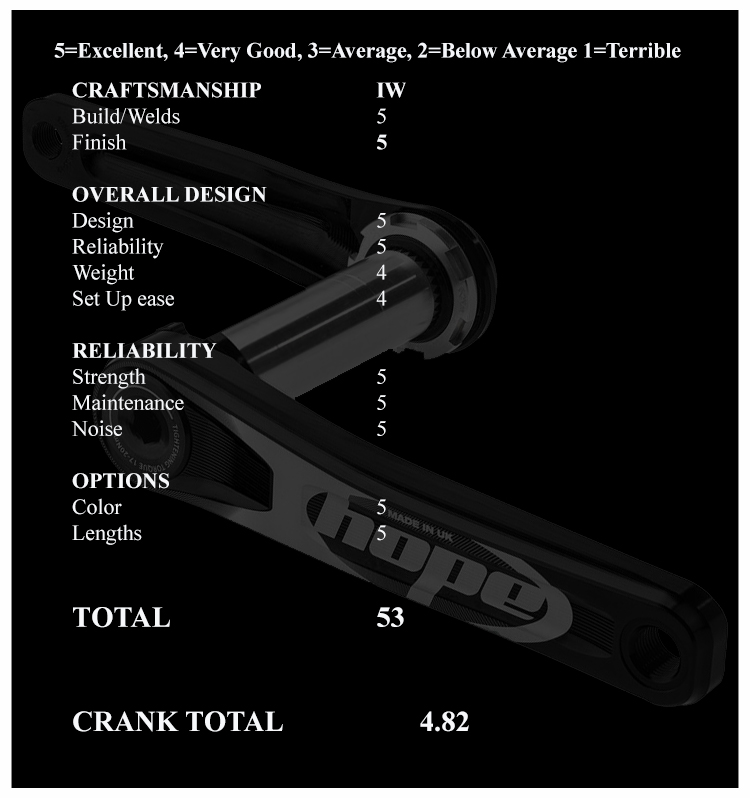
Hope Crank Set Q n A
1. What was Hope's primary goal in creating and designing the cranks?
As with all our products, we're making a part we needed for our own bikes.
2. Can you please explain the axle interface being used on your cranks?
We use an expanding spline. This means that even after the cranks have been removed several times, they can still be refitted as securely as the first time, without creaking! Many cranks relying on tapered splines become worn and don't offer this reliability.
3. Was weight or stiffness of more importance?
Weight is never our primary goal. All our products must perform first, then we look at the weight. As it turned out though, with using a forged crank arm we've managed to produce a stiff crank, at the lower end of the weight range. So they're still light enough for an XC bike, yet stiff enough for DH
4. Is it hard building cranks with all the different standards and Q Factors being used these days?
Not with the modular crank system we've created. All the crank arms are the same, but you simply fit different axles for different width frames. We can also accommodate boost simply by swapping the spider/direct mount chainring.
5. Any tips for installing The Hope Cranks?
Yes – make sure you read the instructions. Sounds obvious but our cranks look similar to some other brands, but they are pulled onto the splines differently.
6. What is the most popular crank arm length would you say?
Has to be 175mm
7. Hope has been around a very long time can you give us a brief overview of the company?
Hope was started in the late 80's by friends Ian Weatherill and Simon Sharp. They were toolmakers and left Rolls Royce to setup their own tool making business. Coming from a motorcycle trials background they weren't happy with the brakes on their bikes so along with one of the guys working for them they designed a bicycle disc brake. They began selling them along with hubs, but initially it was the hubs that really took off. This idea of making parts for ourselves has continued through to the present day. We're probably one of the first 'rider owned' companies in mountain biking, with Ian and Simon still having complete ownership of the company and coming into the factory everyday.
8. What do you think were the top 3 advancements in MTB technology in the last 20 years?
Disc brakes (little bias), suspension and the dropper seat post.
9. Climbs or descents?
Descents every time- it’s what makes the climbs worth it!
10. Rocks or jumps? Rocks
11. What do you think the future holds for the industry as a whole?
The worry is that this explosion of wheel sizes could put off riders from continuing with mountain biking as a sport. They will think it's simply too confusing.
12. Would you rather have the skills of Nico or Ricky Carmichael in their primes? Nico
13. Is it hard for you guys to keep production in England and still keep you prices close to competitors that have moved production to Asia?
Not really since we're in the upper end of the market. We can't make the true mass production parts of the lower end, but if it's high end performance parts then it's achievable.
13. You have been teasing some carbon bars, and bike frames recently are you going to see these soon?
Watch this space….
 Crankset,
Crankset,  Hope Cranks,
Hope Cranks,  Hope Technology |
Hope Technology |





